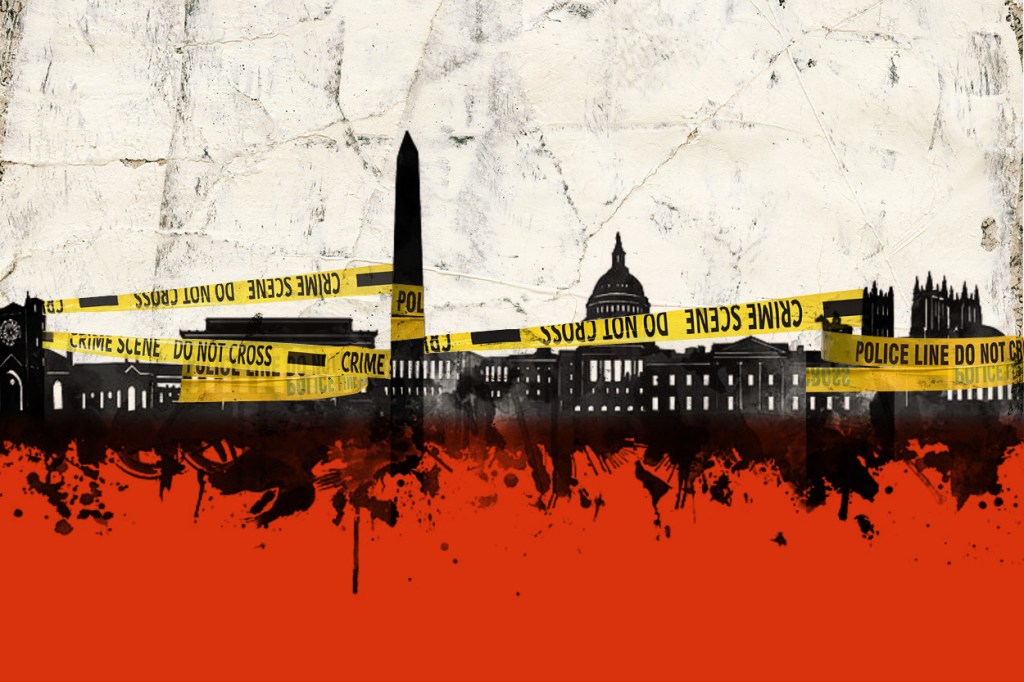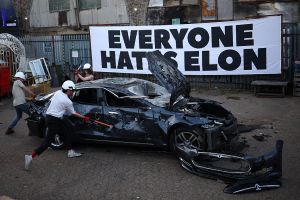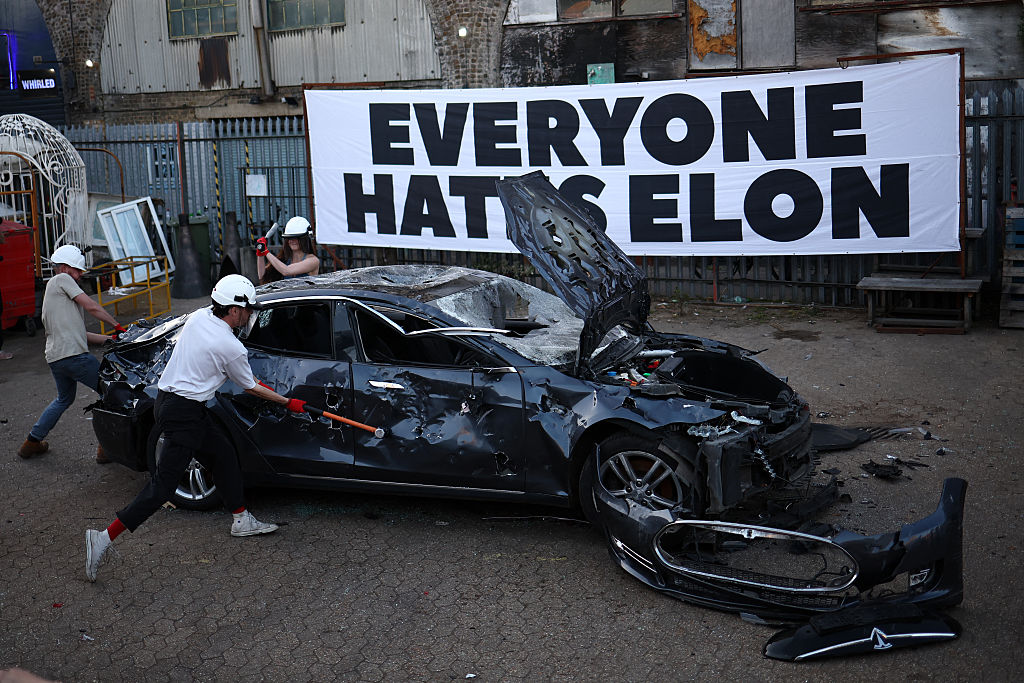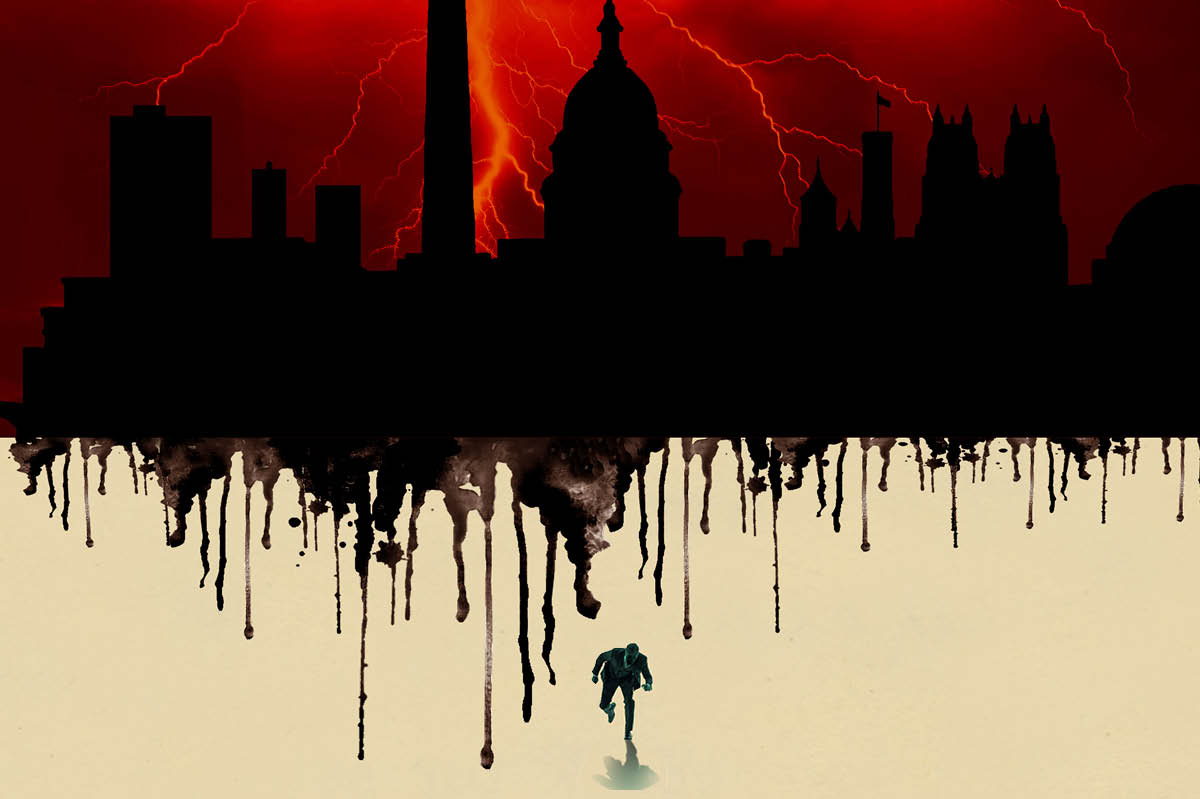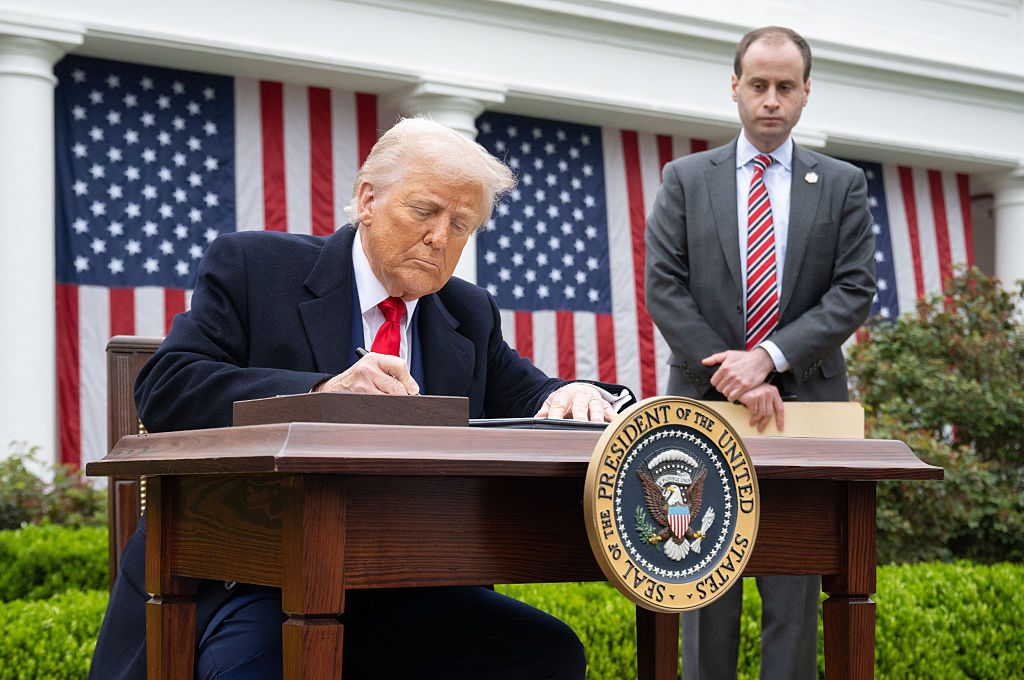A few weeks before Easter, a staffer for Republican senator Rand Paul was randomly and brutally attacked in downtown Washington, DC. The staffer, Phillip Todd, was leaving dinner with his friend when an assailant stabbed him four times in the abdomen, skull, brain and lungs. He suffered a punctured lung and potential brain bleeding. Todd was rushed to hospital, where he was operated on and ultimately survived the attack.
The man who stabbed Todd is a forty-two-year-old named Glynn Neal. Like many of DC’s violent criminals, Neal has a lengthy rap sheet. Virginians for Safe Communities, a nonprofit organization, detailed the man’s long history of criminal behavior. Prior to 2010, Neal was arrested more than twenty times for offenses relating to drugs, guns and assault on a police officer. In 2011, he was convicted of forcibly pimping out women and sentenced to just over twelve years in prison.
Around 2021, the details get sketchy. Neal was released at some point and violated his parole, though the violation was dismissed by a judge. Neal ended up back in prison anyway, but was released again, the day before he attacked Todd. The Metropolitan Police Department said in a statement that Neal was released with “Good Time Credits.”
Christopher Barnard, vice president of the American Conservation Coalition, was with Todd when he was attacked. He was able to tackle the assailant and rush Todd to safety. “It was jarring to learn of the attacker’s criminal record, not least because he was let out of prison early,” Barnard told The Spectator. “It’s hard to get to grips with the fact that such a brutal attack on your friend was, ultimately, so preventable.”
Another all-too-familiar tragedy played out less than a week later. This time, the victim didn’t make it out alive. On March 31, Christy Bautista traveled from Harrisonburg, Virginia, to attend a concert in Washington. Less than one hour after she checked into the Ivy City Hotel in northeast DC, an unknown man entered her room. Bautista attempted to get away. Another guest heard her cries before the door to her room was slammed shut by the assailant. Bautista was stabbed thirty times. Police arrived to find forty-three-year-old George Sydnor Jr. covered in Bautista’s blood, smoking a cigarette. One half of a broken kitchen knife was recovered in one of the room’s beds, the other half in Sydnor’s pocket.
Sydnor was already facing prison time over a guilty plea in an attempted robbery case and was awaiting trial for larceny in Prince George’s County, Maryland. He was released on the attempted robbery charge pending sentencing in January, and skipped out on subsequent court dates in both cases.
These random, violent attacks have become increasingly common in the nation’s capital. While overall crime has decreased in the past two decades, violent crime is trending in the other direction, with rates far higher than they were prior to 2020. And while violent crime dropped slightly between 2021 to 2022, 2023 is off to an ominously violent start. Four months into the year, it’s clear that there is a problem in the nation’s capital. Homicides are up 31 percent from the same time last year. Sex abuse is up 81 percent. Auto thefts have doubled. Violent crime is back to 2021 levels.
“It’s easy to dismiss crime in DC as yet another distant, abstract statistic. That is, until you get your own friend’s blood on your face, after being attacked in broad daylight mere blocks from the Capitol,” Barnard said. “This could happen to anyone and it’s time for DC to take crime seriously.”
***
The Brennan Center for Justice, a nonprofit law and public policy institute, notes that the significant increase in auto theft and carjackings is of special concern because “motor vehicle theft has also been linked to more serious crimes, like murder.”
Last month, the DC police chief revealed that the average murder suspect in DC has previously been arrested nearly a dozen times. “We need to keep violent people in jail,” Chief Robert Contee of the Metropolitan Police Department said. “Right now, the average homicide suspect has been arrested eleven times prior to them committing a homicide. That is a problem.”
Contee’s plea for a common-sense response to the violent crime surge stands in stark contrast to the approach of other city officials who have refused to take the problem seriously, instead championing soft-on-crime policies that make it easier for offenders to avoid serious jail time.
Alan Henney, a longtime crime, fire and EMS reporter who uses his Twitter account to send out seemingly ever more frequent Washington-area crime alerts, alleges that the city council has been “completely oblivious” to the spike in crime.
“What we are seeing now is a disaster that could return DC back to the state it was in the late 1960s or early 1970s,” Henney told The Spectator. “Stolen autos and carjackings are clearly fueling the current crime spike. The police are unenthusiastic and overworked, the prosecutors are soft on crime, and criminals are getting on the street who clearly should have never been released without proper guidance, socialization and monitoring.”
Much of the city’s focus on criminal justice reform has been at the behest of Charles Allen, an Alabama native and DC councilmember who represents Ward 6. In 2016, Allen urged the DC Council to pass the Incarceration Reduction Amendment Act, a law that significantly changed how the criminal justice system treats young offenders.
The law gives offenders who were convicted when they were minors in the Superior Court (DC’s adult criminal court) the opportunity for early release. After serving twenty years of their sentence, the youthful offender may petition the court for early release. The court can then reduce the offender’s sentence after considering the nature of the crime and the potential for re-offense. (Minors are typically only tried in Superior Court if they are accused of serious crimes such as rape or murder.)
A 2018 amendment made it even easier for violent youth offenders to get out of prison. Judges were no longer allowed to consider the nature of the offense, and minors could file for early release after serving just fifteen years, even if they had already been denied parole. The new law also prohibited sentences of life without parole for minors, and charged that judges “shall” rather than “may” rule in a defendant’s favor so long as they met the minimum requirements for early release.
The city council revisited the law yet again in 2019, this time aiming to make it applicable to violent offenders up to the age of twenty-five. The Washington Post editorial board excoriated the proposed change: “The effect would be to allow many of the city’s most violent offenders to seek release from prison in their thirties, regardless of their original sentences.
“Out the window would go transparency and truth in sentencing — the assurance to victims and the community that punishment is what it appears to be,” the editorial board said. “By discouraging judges from considering the original crime when they weigh reducing sentences, the council is putting the public at increased risk, unnecessarily.”
The US Attorney’s Office in the District of Columbia explained in a press release criticizing the legislations that “Bureau of Prisons data suggests that of the 583 eligible criminals who could apply for early release under the proposed Amendment, one in three will reoffend within three years of release.”
Despite these objections, the DC council passed the Second Look Amendment Act unanimously in December 2020. DC mayor Muriel Bowser signed all three of these major legislative changes to the criminal justice system.
***
With more and more soft-on-crime laws in place, pandemic policies made Washington’s crime problem worse. Rising violent crime rates can be, in part, be attributed to Covid lockdowns, which were championed by the DC city council members and the mayor. Schools were shut, and local community leaders said they were unable to provide the type of services to the city’s at-risk population that would typically help reduce their propensity to commit crimes.
On a national scale, “sudden and unprecedented hardships jeopardized the stability of families and communities alike,” the Brennan Center explained. “Combined with other disruptions caused by lockdowns and social distancing measures, they may have upset the informal social processes — such as connections to neighbors, family members and employers — that some researchers believe help keep neighborhoods safe.”
Homeless encampments, which tend to attract drug-addicted and mentally ill people, became common around DC as the National Park Service stopped enforcement of its no-camping policy during the pandemic. In one DC encampment, located at an underpass in the NoMa neighborhood, a stunning 80 percent of homeless residents said they had a diagnosed mental illness. NPS officers who were present at the recent clearing of an encampment at McPherson Square, located just blocks from the White House, said the tent cities were the source of numerous calls they received over the years. NPS intends to clear all of the city’s encampments by the end of 2023, much to the chagrin of left-wing activists who have shown up to protest the removals. Homeless people are offered shelter, housing vouchers and addiction and mental health services from the city during displacement.
The lockdowns were incredibly detrimental to at-risk youth, who lost access to in-person education and after-school services. Many of them turned to crime to keep busy; local authorities describe a rise in teen carjackings, for example, as something resembling a TikTok trend. “They have friends who see them do it, they do it. We’ve had young people committing carjackings and while they’re being pursued by the police, they’re livestreaming themselves laughing,” DC police chief Robert Contee said. Eduardo Ferrer, a professor at the Georgetown Juvenile Justice Clinic, described teen crime patterns as “faddish”. The number of teens committing carjackings in DC increased fourfold between 2019 and 2021. An Uber Eats driver was killed in 2021 during a carjacking by two teenage girls, one thirteen years old and the other fifteen years old. A fourteen-year-old girl was arrested last week after using pepper spray in another carjacking.
Although there was generally less opportunity for crime during the pandemic, the few people who did leave their homes were more likely to become victims of street crime, contributing to a feeling among citizens that they were not safe in public. Before the pandemic, downtown DC was awash with professionals and within high-density areas, crowds tend to dissuade crime (safety in numbers, after all). Remote work remains popular in DC — as of January 2023, office occupancy sat at a measly 46 percent — and tourists are only recently turning out pre-pandemic levels. Persistent urban flight means empty city streets being ceded to criminals.
***
You might think the convergence of these dangerous trends would force DC officials into a fundamental rethink of the city’s approach to crime. But, despite the sense of looming danger that’s enveloped the city, they seem intent on making things easier for criminals. While working through what were supposed to be minor updates to the city’s 120-year-old criminal code, the city council, in a move spearheaded by Councilman Allen, decided to throw in major revisions. Allen claimed the code was fundamentally flawed because it was written by slaveowners. The updated code would have removed mandatory minimums for nearly all crimes and lowered the maximum sentences judges could hand down for some crimes, including carjackings.
These changes were deemed so heinous amid the city’s crime wave that Mayor Bowser vetoed the legislation and suggested a set of amendments for the council to consider. It seemed to be the latest example of Bowser’s rather paradoxical approach to crime in the city; although she has signed onto most of Allen’s proposed criminal justice reforms, she has also repeatedly supported increasing funding for the MPD.
This city-level issue garnered national attention when the council overrode the mayor’s veto, prompting Congress to step in and exercise its authority to review all legislation passed in the nation’s capital. A Republican-sponsored measure to block the DC crime bill passed with significant Democrat support in the House and Senate. Joe Biden eventually recognized how bad crime has become in DC and flip-flopped on a promise to not interfere in the city’s affairs. He rebuked progressives and announced he would not veto the congressional move to block the city’s crime bill. The president’s flip-flop made this the first time in three decades that Congress had overturned a measure from the DC council.
Following this federal rebuke, the House Committee on Oversight and Accountability held a hearing to examine crime and homelessness in the city and hinted that other DC council measures may soon be on the chopping block.
Allen, who is white, isn’t so out-of-touch with DC residents’ attitudes about how to tackle rising crime. Polling of 500 residents found that a wide majority of Washingtonians, including those residing in Wards 7 and 8 — areas east of the Anacostia River which tend to boast higher levels of crime as well as larger minority populations — supported Allen’s proposed changes to the criminal code.
At the same time, residents are clear-eyed about the fact that there is a problem. A Washington Post poll found that 30 percent of Washingtonians do not feel safe in their neighborhoods, the highest in the Post’s two decades of polling. A plurality of residents named crime as the biggest issue facing the city. More than 40 percent of residents feel unsafe in Wards 7 and 8. Seegars, a Ward 8 resident and leader of Concerned Residents Against Violence, suggested that the city council was not totally honest about what was going to be in the updated criminal code. “The council should have had meetings about this bill in every ward,” she said. “Why would you reform the laws and not the criminals?”
The city council is not the sole party to blame for a weak-on-crime approach in DC. US attorney Matthew Graves, who was appointed by Biden, has failed to prosecute about two-thirds of crimes committed in the city, a rate two-times higher than just seven years ago. Graves has tried to blame outside factors for his failure to prosecute, but his excuses don’t explain why there is a major discrepancy in his rates of prosecution for violent versus nonviolent offenses.
Judges are part of the problem too. In February, Congresswoman Angie Craig was assaulted in the elevator of her apartment building. Federal magistrate judge Zia M. Faruqui originally ordered the assailant, Kendrick Hamlin, to be released from jail and sent to a facility where he could receive treatment for his alleged mental disorders. A federal prosecutor noted that Hamlin had twenty-five bench warrants for failing to appear in prior cases and that the facility had no security or locks preventing Hamlin from leaving. Faruqui said it was a “close call” as to whether or not Hamlin should stay in jail until trial, and issued a stay on his own order until a follow-up hearing.
A judge appointed by President Joe Biden had initially ordered the release of the man who went on to murder Christy Bautista in her hotel room.
The lackadaisical approach to crime by prosecutors and judges impacts policing. The Metropolitan Police Department often refuses to pursue relatively minor crimes or advises victims not to press charges because of an assumption that the cases won’t go anywhere.
Joel Griffith, a research fellow at the Heritage Foundation, recently shared a familiar scene at DC’s Union Station where a homeless man was taunting and threatening commuters. Police told Griffith that the “DC government releases this individual (and others who are threatening) almost immediately after detainment.”
After my fiancé was assaulted by a vagrant in downtown DC in 2020, police urged him multiple times not to press charges against his assailant. They initially warned him he would have to take off work to appear for the case before eventually admitting that it wasn’t “worth the trouble” because the man would merely be released after booking and probably wouldn’t face much, if any, jail time for his crime.
Police are also hamstrung by staff shortages. Chief Contee notes that he has 430 fewer officers than he did in 2019 and speculates the department hasn’t been as small as it is now since the 1970s. Although Mayor Bowser supports increasing funding for the police, the city council ended up cutting the MPD budget by millions in 2020. In a recent workaround, Bowser upped the city’s police signing bonus to $25,000. Police shortages are not a problem that is unique to DC; police departments across the country say they are struggling to recruit and retain officers because of nationwide anti-police sentiment. Protests against alleged racial bias in policing and police brutality, plus political movements to “defund the police” and end qualified immunity have all severely damaged morale among the Blue.
***
The refusal by officials to tackle the DC crime problem has led some to take matters into their own hands. Monumental Sports & Entertainment, the group that owns the Washington Capitals and Nationals, is hiring more off-duty DC police officers to secure the area around Capital One Arena and Nationals Park. There were several shootings near Nats Park last year, including one that occurred during a packed baseball game.
Henney said he hopes his account can help “heighten peoples’ awareness of the different types of crime and hopefully help them avoid becoming a victim.” He has not received much support from council members, but said members of the Advisory Neighborhood Commission have frequently reached out to discuss the crime issue with him. ANC members are elected officials who serve on boards dedicated to improving life in their respective neighborhoods.
K. Denise Rucker Krepp, a Democrat who represents about 2,500 Capitol Hill residents, says she has been fighting her own party in its response to the DC crime wave. “I really don’t understand why they just seem to be so gung-ho on helping individuals who committed rape, and murder, and armed carjacking, stabbing, shootings, robberies, whatever,” she told Fox News. “It’s truly puzzling to me.”
The DC Guardian Angels, which were formed in 1989, have begun patrolling metro stations again to assist shorthanded police officers.
“We’re planning on going out there, if we see something we’re going to report you because enough is enough. We have to make the Metro safe for our citizens of DC to live and work,” the group’s founder, John Ayala, said in a recent interview.
In perhaps the most extreme example of vigilante justice, a DC-employee shot and killed a thirteen-year-old boy who he caught breaking into cars outside his home earlier this year. Jason Lewis is charged with second-degree murder while armed.
Mayor Bowser, when she’s not touring Anacostia with Dr. Anthony Fauci to lecture residents about Covid vaccines, appears to be, at least on a surface level, taking the crime issue seriously. She acknowledged that she feels a greater anxiety among DC residents about crime now than she did growing up during the city’s crack epidemic.
Since the start of the year, Bowser has held meetings with public safety officials and the ANCs to discuss the best ways to reduce violence. However, as evidenced in the public brawl over the recent crime bill, the DC city council remains a committed foe to public safety in favor of racial equity. If the nation’s capitol continues to spiral amid the standoff between traditional Democrats and the progressive left, it might be time for the feds to take the wheel.



